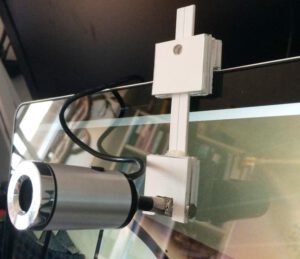My monthly tip for virtual leaders – February
It is a fact that we need eye contact – at least to some degree – when we want to have a trustful conversation and good connection with someone we communicate with. In face-to-face settings that is easy enough and doesn’t require any further thought.
But what about online meetings? How easy is it to have eye contact then?
Or is that maybe part of the reason why some people don’t like to have deeper and meaningful conversations over the web? Because they often get the impression the other person isn’t really engaged in the conversation because (s)he doesn’t seem to look at us? The thing is: they do look at us! Technology is working against us here.
Making eye contact
 When using video communication platforms we normally and automatically look into the other person’s eyes on our screen because that is what we are used to. Yet, to the other person it often appears as if we look down and do not engage entirely. And our eyes never really meet. That is caused by the position of the webcam, usually located slightly above the actual screen. Hence, when we look straight into the person’s face and eyes we are actually not looking into the camera so that it appears to them as if we are looking down and are focussed on something else. And depending on our position relative to the monitor, this effect is more or less pronounced.
When using video communication platforms we normally and automatically look into the other person’s eyes on our screen because that is what we are used to. Yet, to the other person it often appears as if we look down and do not engage entirely. And our eyes never really meet. That is caused by the position of the webcam, usually located slightly above the actual screen. Hence, when we look straight into the person’s face and eyes we are actually not looking into the camera so that it appears to them as if we are looking down and are focussed on something else. And depending on our position relative to the monitor, this effect is more or less pronounced.
But there is something we can do about this! And here are some ideas how I overcame this challenge!
A simple solution
 Since we are not continuously looking into each other’s eyes even when talking with each other in a face-to-face situation, the easiest solution for an online setting could be that you occasionally raise your eyes and look into your webcam whilst speaking with a person via an online connection. This may sound strange and certainly feels strange at first. However, I highly recommend trying it out and see what the effect is with your counterpart.
Since we are not continuously looking into each other’s eyes even when talking with each other in a face-to-face situation, the easiest solution for an online setting could be that you occasionally raise your eyes and look into your webcam whilst speaking with a person via an online connection. This may sound strange and certainly feels strange at first. However, I highly recommend trying it out and see what the effect is with your counterpart.
Of course, the downside is that you will not directly see the facial expressions of the other person when you focus your eyes on the camera. At best you will notice it in the peripheral vision. Thus, it’s the second-best solution to simulate actual eye contact and I am convinced it already makes a difference in the exchange.
A great solution that works
So, how can you overcome the challenge of looking into the webcam to simulate eye contact and not miss the facial expressions of your counterpart?
You have to minimise the angle between the other person’s eyes and your webcam! The only way to achieve that is to mobilise your camera. How does this work?

Here are my solutions:
For a laptop, you need to use a separate webcam, not the built-in one. The cost for good quality webcams nowadays is low enough, around €20. With a small holder you can mount the separate Webcam on your laptop screen and move it up and down, manually, to position it, ideally, in the area where your counterpart’s forehead appears on the screen. To illustrate what I mean I’ve taken a picture of the system I have created myself. With some DIY skills, it’s relatively easy to do.
For a desktop monitor it may be trickier and may require a more sophisticated system or even very different approaches. Originally, I had started with a relatively simple system. I took the webcam off its holder and fastened it with bungee cord around the monitor on a manually movable holder.
A more sophisticated version, my engineer heart had asked for it, is now a motorised frame that flexibly positions the webcam in front of my desktop screen. This allows me now, with a control box for the different drives, to position my webcam slightly above where my counterpart’s eyes are. So, by looking straight at them, I automatically also look straight into my camera.
This does not mean that I move the webcam every time the other person moves their head! My experience shows that even if people move around slightly when talking, they have a natural position they return to throughout the conversation. And that is where I position my camera.
Whatever idea you are going to use, the key principle is to minimise the distance between the webcam and the eyes of your counterpart on the screen without obstructing too much of their face.
If you like to know more about this and discuss some ideas and practicalities feel free to get in touch with me. I’m happy to share my insights and ideas.




Hello, did you find an easier solution about eye contact online? I teach presentation training and I do not think I can get my clients–only the engineering ones, to make something. I love what you did. And it is a good idea to look into the camera some…but for us super visual types hard not to want to look at the person’s face. A colleague of mine put his camera on a tripod next to the computer monitor.
Thanks for your ideas. Loved seeing what you created!
Dear Claudyne, Thank you very much for your comment. Indeed it is not so simple to build it yourself, I must admit. I have developed a new idea which will be part of a post soon to come. In the meantime I have sent you a video link about this idea.
Thank you for a great article. In my work as an image coach, I find that many people who have otherwise mastered a professional image, do not consider how they appear to others on camera. Looking into the camera can take practice. Is the cam holder you demonstrate on the laptop one that you have created yourself, or is there a resource you can recommend?
Dear Patty, first of all my sincere apology for the late response to your comment and question.
The holder I have created for the laptop is indeed a DIY piece.
There is now a company manufacturing such holders for screens at different sizes. For a LapTop they offer this: https://www.plexicam.com/product-page/plexicam-mini
Still pricy but seems fit for the purpose.
I hope this helps.